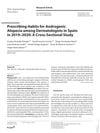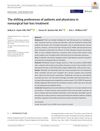Progress Pictures 10.2019 - present Progress Pictures 1/24/2025
The conversation discusses hair loss treatments, including finasteride, topical and oral minoxidil, and the potential use of dutasteride. The user shares progress and seeks advice on whether to start dutasteride, noting positive results with current treatments but concerns about long-term effects.
View this post in the Community →
Similar Community Posts Join
6 / 1000+ resultscommunity We cooked fam? 1 Year on Dut + Oral Min after years of Fin (some mistakes made & details in comments)
The user switched from finasteride and topical minoxidil to dutasteride and oral minoxidil, experiencing some hair shedding but maintaining hair quality. Suggestions include increasing oral minoxidil dosage, considering a hair transplant, and using dermarolling, while some users recommend stopping treatment altogether.
community Results after 1.5 year on DUT (progress pictures)
The user shared impressive hair regrowth results after 1.5 years using dutasteride (DUT) and oral minoxidil. They switched from finasteride and topical minoxidil due to lack of results and experienced no side effects.

community 2025 Official beginner guide for “I’m losing my hair, what can I do?”
For hair loss, start with Finasteride, Minoxidil, Ketoconazole shampoo, and Microneedling. For severe cases, consider Dutasteride, oral Minoxidil, or hair transplants.
community 8 months Oral min and Dutasteride
Oral minoxidil and dutasteride are used for hair loss with mixed results. Some users report new growth, while others suggest scalp inflammation may be an issue.
community 4 month Finasteride and 3 month Minoxidil Results
A user's success in treating his diffuse and crown hair loss with finasteride and minoxidil; other users sharing their experiences, both successful and unsuccessful, and the importance of research and listening to one's body when deciding on treatments.
community Bryan Johnson shares information on his hair loss stack
Bryan Johnson uses topical dutasteride, minoxidil, and microneedling for hair loss. Users discuss treatment effectiveness and side effects, debating topical versus oral dutasteride efficacy.
Related Research
6 / 1000+ results
research Prescribing Habits for Androgenic Alopecia Among Dermatologists in Spain in 2017: A Cross-Sectional Study
In 2017, Spanish dermatologists commonly prescribed topical minoxidil, oral finasteride, and nutricosmetics for hair loss, with oral contraceptives also used for premenopausal women. Less common were oral dutasteride, due to side effects, and newer, more expensive treatments like topical finasteride and Low-Level Laser Therapy. The conclusion is that there's a need for prescription guidelines due to varied treatment approaches.

research Prescribing Habits for Androgenic Alopecia Among Dermatologists in Spain in 2019–2020: A Cross-Sectional Study
In Spain, dermatologists most commonly prescribe topical minoxidil and oral finasteride for male hair loss, and topical minoxidil and oral contraceptives for female hair loss. The use of oral dutasteride and oral minoxidil has significantly increased over the past three years.

research The Shifting Preferences of Patients and Physicians in Nonsurgical Hair Loss Treatment
Minoxidil and Finasteride are the most popular hair loss treatments, with rising interest in other options, and economic or health crises can change what treatments people prefer.

research Cross-Sectional Study on Prescription Habits in Androgenetic Alopecia Among Dermatologists in Spain in 2017
In 2017, Spanish dermatologists most often prescribed minoxidil and finasteride for male hair loss, and minoxidil and oral contraceptives for premenopausal female hair loss.
research The Use of Oral Dutasteride, Minoxidil, and Finasteride for Treating Endocrine Therapy-Induced Hair Loss from Breast Cancer Treatment: A Case Series Study
Oral dutasteride, minoxidil, and finasteride may help reduce hair loss in breast cancer survivors, but more research is needed.

research Relative Efficacy of Minoxidil and the 5-Alpha Reductase Inhibitors in Androgenetic Alopecia Treatment of Male Patients
Dutasteride is the most effective hair loss treatment after 24 weeks, but finasteride leads to the most hair growth after 48 weeks.